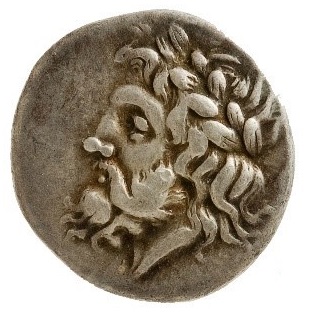Title: Hemidrachmon of the Arkadian League, Megalopolis - 1987.01
Acquisition number: 1987.01
Author or editor: Douglas Kelly
Culture or period: Classical Greece.
Date: c. 370 -280 BC.
Material: Metal - Silver
Object type: Coins - Greek
Dimensions: 17mm (w)
Origin region or location: Greece
Origin city: Megalopolis.
Display case or on loan: 5
Keywords: Coin, Greek, Classical, Arcadia, Arkadia, Megalopolis, Zeus, Pan, hemidrachmon
(1) A. Walker, Coins of the Peloponnesos: The BCD Collection (Auction LHS [8-9 May 2006], LHS Numismatics, Claremont, CA, 2006); (2) (Classical Numismatic Group 81/2 [20 May 2009]), 1522 - 3.
O. Hoover, Handbook of Greek Coinage 13 vols (Classical Numismatic Group, Lancaster, PA, 2009-2013), 5, 929.
Sylloge Nummorum Graecorum, Copenhagen, The Royal Collection of Coins and Medals, Danish National Museum, repr. edn (West Milford, NJ, 1981-), 195.
Classical Numismatic Group Auction, 396 197.
1987.01
Hemidrachmon of the Arkadian League, Megalopolis
Silver, 2.80 g. 17 mm. c. 370-280 BC.
Obv.: Laureate head of Zeus l.
Rev.: Pan seated l. on rock, right hand raised, left hand holding lagobolon; monogram ΑΡΚ to left; Ι to right.
A lagobolon is a throwing-stick for killing hares; it was also used as a crook and was thus a suitable implement for Pan, a god of the wild and of herds. The monogram ΑΡΚ stands for ΑΡΚΑΔΩΝ (‘of the Arkadians’). The iota (Ι) to right is apparently a mint-mark, or a control-number added to a batch of coins to identify the officials who produced them.
Not long after Sparta’s defeat at Leuktra in 371 BC, the numerous Arkadian states in the central Peloponnese united into a new Arkadian federation. They were assisted by the presence of a large Boiotian army under Epameinondas, who was honoured as one of the founders of the new Arkadian federal capital of Megalopolis. The Arkadians had previously been under the dominance of Sparta, which had encouraged and enforced the separate existence of small Arkadian poleis, in the interests of keeping control. The 360s saw a new self-assertiveness and sense of self–importance in the Arkadian federation, which revived aspirations for unity that had surfaced in the fifth century.
With a standing professional army to support, as well as the construction of a new capital, the Arkadian federation had practical as well as sentimental reasons to issue a federal coinage. Silver hemidrachma and obols and bronze coins were produced, the silver on the ‘reduced Aiginetan standard’ common in the Peloponnese from the latter half of the fourth century BC onwards. The weight of this hemidrachmon indicates that it was produced in the earlier phase of this coinage (c. 370-280 BC). Later hemidrachma of this type are lighter (c. 2.40-2.30 g.) in a coinage that was still being minted in the second century BC.
The images on the silver coins refer to the two most important cults in Arkadia, both located on Mount Lykaion, the tallest peak in Arkadia and known locally as the ‘Sacred Mountain’, or Olympos. Pan and Zeus were worshipped there, the latter in a cult said to be of great antiquity: Pausanias (8.38.6) records a common belief that any person entering the sacred enclosure of Zeus Lykaios had to be killed and any animal entering it was believed to lose its shadow and die within a year.
(1) A. Walker, Coins of the Peloponnesos: The BCD Collection (Auction LHS [8-9 May 2006], LHS Numismatics, Claremont, CA, 2006); (2) (Classical Numismatic Group 81/2 [20 May 2009]), 1522 - 3.
O. Hoover, Handbook of Greek Coinage 13 vols (Classical Numismatic Group, Lancaster, PA, 2009-2013), 5, 929.
Sylloge Nummorum Graecorum, Copenhagen, The Royal Collection of Coins and Medals, Danish National Museum, repr. edn (West Milford, NJ, 1981-), 195.
Classical Numismatic Group Auction, 396 197.

